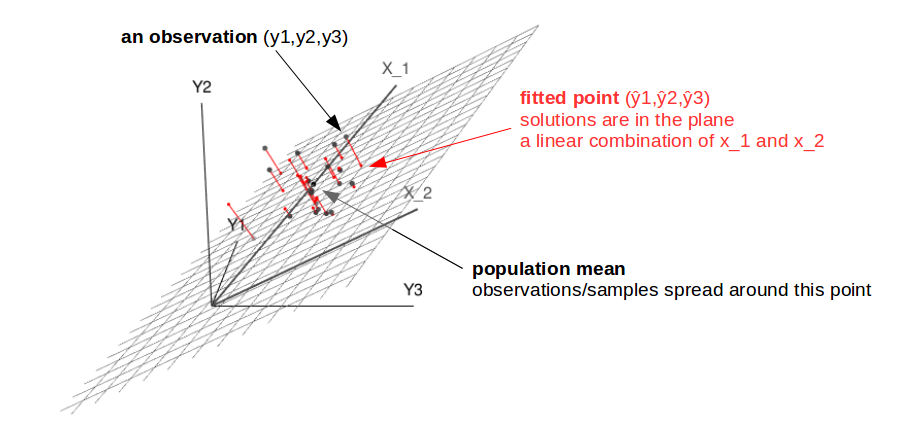The effect of subtracting the mean...
... the same type of correlation occurs in residuals of a linear regression, which are correlated.
An image that illustrates this is in the question Why are the residuals in $\mathbb{R}^{n-p}$?
In the example below, you see an illustration for the fitting of $\mathbf{y} = a + b\mathbf{x}$ with only three points.

The error is a vector perpendicular to the surface spanned by $x_1$ and $x_2$. For any observation, the error will point in the same direction and can be seen to be a multiple of a line (a 1D space).
In the above image, no matter what the data-point is, the residual will be along a 1D vector.
In a 2-sample case the effect is the strongest and the residuals are fully correlated $$\begin{array}{rrr}x_1 - \bar{x}& = &\frac{1}{2} (x_1 - x_2) \\ x_2 - \bar{x} &= & -\frac{1}{2} (x_1 - x_2)\end{array}$$.
For multiple samples the residuals can be computed with the residual maker matrix
$$A = I - X(X^TX)^{-1}X^T = \begin{bmatrix}
1-\frac{1}{n} & -\frac{1}{n} & -\frac {1}{n}& \dots & -\frac{1}{n} \\
-\frac{1}{n} & 1-\frac{1}{n} & -\frac {1}{n}& \dots & -\frac{1}{n} \\
-\frac{1}{n} & -\frac{1}{n} & 1-\frac{1}{n} & \dots & -\frac{1}{n} \\
\vdots & \vdots & \vdots & \ddots & \vdots \\
-\frac{1}{n} & -\frac{1}{n} & 1-\frac{1}{n} & \dots & 1-\frac{1}{n} \\
\end{bmatrix}$$
For the offdiagonal elements $A_{ij} = -1/n$ and for the diagonal elements $A_{ii} = 1-1/n$.
If you start with Gaussian white noise, then the residuals will be multivariate normal distributed with covariance matrix $$\Sigma_{ij} = AA^T = \begin{cases}
1-\frac{1}{n} & \quad {\text{if $i=j$}}\\
-\frac{1}{n} & \quad {\text{if $i\neq j$}}\\
\end{cases}$$
The correlation between different terms in the time-series will be $$\rho = \frac{cov(x_i,x_j)}{\sqrt{var(x_i)var(x_j)}} = - \frac{1}{n-1}$$
For your case with $n=10000$ we would expect a correlation $\approx 10^{-4}$. I am not sure what causes the discrepancy with your results.



corfunction, using the mean of the entire series instead of the two means of the sub-series as the estimate of the means, the problem disappeared, so it appears to me that you are correct. Why not write that up as an answer? $\endgroup$